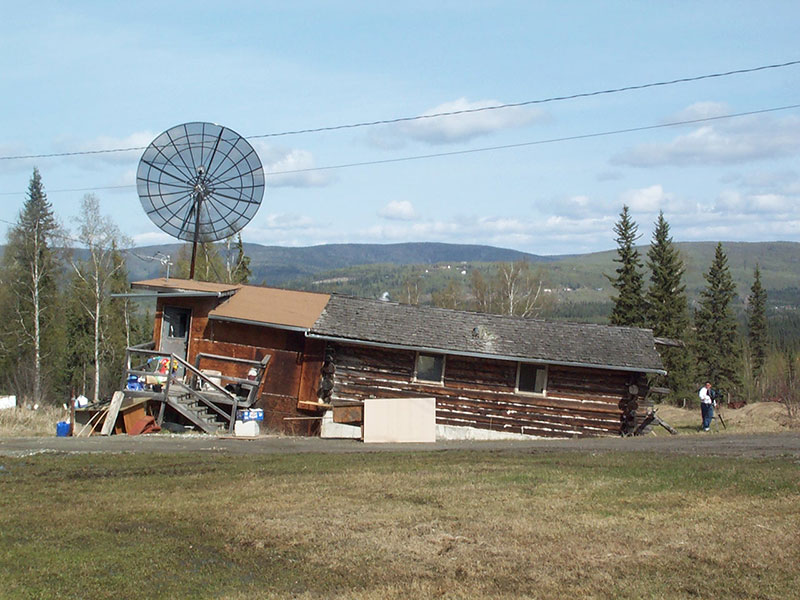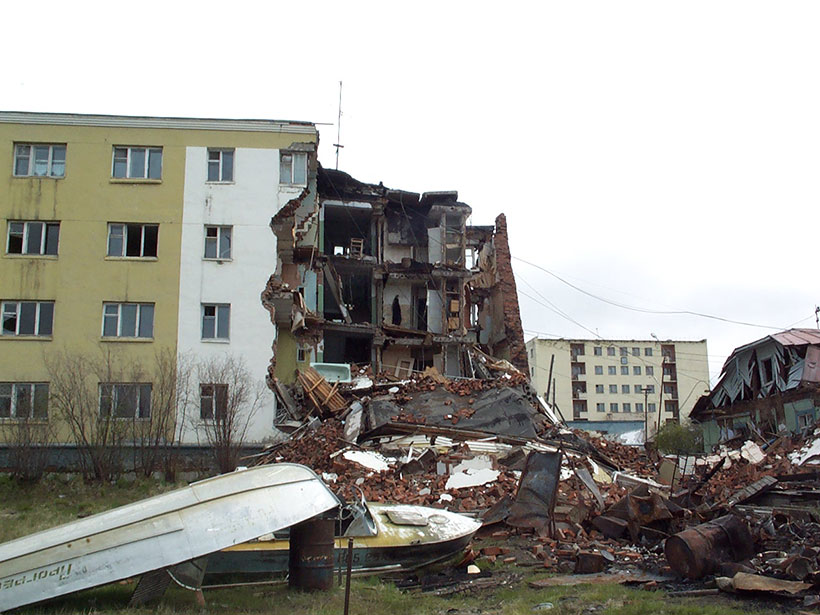An Arctic ecosystem is in crisis this month after a fuel tank in Russia collapsed and spilled 20,000 tons of diesel into the environment. Thawing permafrost and aging facilities likely caused the spill, and the ecosystem could take more than a decade to recover.
Although Arctic communities have long known that warming temperatures will undermine buildings, roads, and other infrastructure, scientific research is still catching up on how to create localized hazard maps of permafrost thaw. Meanwhile, communities don’t have time to wait for research to catch up.
“I’ve heard of dozens of houses falling in.”
“I’ve heard of dozens of houses falling in, and a few churches. There are multiple graveyards that are falling in, and there’s nothing that anybody can do,” said Darcy Peter, a researcher at Woods Hole Research Center who specializes in permafrost thaw.
Scientists know more about the worldwide impacts, like the carbon emissions of permafrost thaw, than the local impacts on infrastructure. Permafrost characteristics vary widely, so predicting which area will thaw and how fast is difficult.
“The problem is, we have not been able to hand our northern partners, whether it’s an Indigenous community or a northern government, maps of where permafrost is vulnerable to this kind of abrupt thaw,” said Merritt Turetsky, director of the Institute of Arctic and Alpine Research at the University of Colorado Boulder.
Doing so will require more data monitoring, higher-resolution models, and close communication with impacted communities.
Hurdles to Characterizing Permafrost Thaw

Permafrost is “the glue that holds northern ecosystems together,” said Turetsky, but climate change is thawing wide swaths of it. Buildings perched on top are cracking and buckling.
A statewide assessment recently tallied the number of remote Alaskan communities facing environmental threats, including permafrost thaw. Thirty-five of the nearly 200 rural communities listed in the report had a high threat level for thawing permafrost. Another study estimated that damages to public infrastructure in Alaska could cost $5.5 billion by the end of the century.
Although scientists know that permafrost is thawing with warming temperatures, it is challenging to create localized maps of thaw to predict which infrastructure is most at risk. Thaw depends on multiple local factors: precipitation, ground ice content, and temperature, among others. Each factor varies spatially and may require laborious methods to measure.
“The data that we have are extraordinarily time-consuming,” Turetsky explained. One water content measurement requires drilling a core, carting it back to the lab, melting it, and measuring the water content. “We need to repeat that millions of times over in lots of different locations.”
Likewise, regional models of permafrost thaw suffer from coarse resolution. Vladimir Romanovsky of the University of Alaska Fairbanks said that climate models have grid cells hundreds of kilometers wide, when they need tens of meters of spatial resolution. Scientists use climate models to project how permafrost will change in the future.
Pushing Research Forward
Scientists are working hard to provide communities with answers, including collaborating with local leaders to coproduce knowledge and forging ahead with new projects.
Scientists must ask communities about their concerns before creating a research plan, said Peter. “I don’t want to go into a community, not talk to anybody, be there for a few weeks for fieldwork, take a bunch of stuff back, and essentially exploit the resources of a vulnerable place.”
“I believe that there’s a simple answer to research being applicable to locals,” she added—“talking to them, going in there with no agenda, and asking them what’s important to them.”

One initiative working with local communities is a recent National Science Foundation–funded project to place local permafrost monitoring stations in Point Lay, Utqiagvik (formerly Barrow), Wainwright, and Kaktovik. Although permafrost monitoring stations have spanned the Arctic since the 1970s, scientists had intentionally avoided inhabited areas to isolate the impact of climate change on thaw, said Romanovsky. Now scientists are placing monitoring stations within communities to highlight trouble areas.
Solutions must be paired with funding, said Peter. Indigenous and Native communities have applied for funding to move or repair failing infrastructure and have received little help. The recent spill in Russia highlights the need for continuous permafrost monitoring to avoid environmental disasters.
“It’s pretty much common knowledge now that infrastructure will be impacted. But the prediction of how much? Answering very specific questions is much more difficult,” Romanovsky said. “There’s lots of work that needs to be done.”
—Jenessa Duncombe (@jrdscience), Staff Writer
Citation:
Duncombe, J. (2020), The ticking time bomb of Arctic permafrost, Eos, 101, https://doi.org/10.1029/2020EO146107. Published on 24 June 2020.
Text © 2020. AGU. CC BY-NC-ND 3.0
Except where otherwise noted, images are subject to copyright. Any reuse without express permission from the copyright owner is prohibited.

